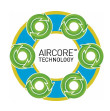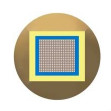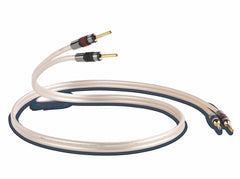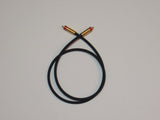QED Reference XT40i Speaker Cables - Closeout Sale
Founded by Bob Abraham and Ian Vine in 1973; QED has, over the past 40 years, acquired unparalleled knowledge and experience of hi-fi and home cinema cables and connectivity.
We are the market leader but we’re certainly not complacent. Our design engineers constantly investigate new technologies and undertake scientific research to ensure we always offer our customers the very best products on the market. As far back as 1994 we conducted the most extensive ever scientific investigation into the effects of speaker cables on hi-fi system performance. The results were astonishing, and can be found on our website under the heading ‘The Genesis Report'. The report produced clear evidence that speaker cables do matter, and we continue to use this information today. We urge you to try QED cables for yourself. If you do you’ll discover the differences in sound quality that QED hi-fi cables can really make.
Key Technologies Overview

Silver Plated 99.999% Oxygen Free Copper
Speaker cables must exhibit the lowest possible resistance to the flow of electrical current. The larger the cross- sectional area of the conductors the smaller the resistance will be. However the cable must be small enough to be practical for its intended use. Although copper is a very good electrical conductor, silver is even better. By using it in our top of the range cables we can improve conductance without making the cable larger. As the pitch of the sound increases the current flows more and more to the outside of the conductors so we cunningly use silver plated 99.999% oxygen free copper conductors to reduce resistance only where it is needed, thus saving you money.

Low Loss Dielectric
Music signals in a loudspeaker cable move back and forth many times every second. The insulating material used to separate the send and return conductors from each other (the dielectric) has to be charged and discharged every time. Not all of the energy stored in the dielectric during each charge cycle is completely returned during each discharge cycle which has a detrimental effect on the fidelity of the sound you hear. That's why at QED we use low loss dielectric materials such as Polyethylene (PE) or Teflon(TM) (PTFE) in preference to cheaper PVC alternatives found in inferior unbranded cables.

X-Tube Technology
In loudspeaker cables high pitched sounds are forced to travel towards the outside of the conductor and so are able to use less and less of the available cross-sectional area as the pitch increases. This is called the "Skin Effect". It means that for high frequencies the resistance of the cable appears to be much higher than it does for lower pitched sounds. This has a detrimental effect on the fidelity of the sound you hear. QED X-Tube Technology solves this problem by creating a hollow tubular conductor geometry through which each frequency can pass with equal ease when compared to traditional solid or stranded conductors.

Air Core Technology
In loudspeaker cables electrical current does not flow smoothly because - rather like in a river - small eddy currents are formed. Eddy currents in one conductor can affect the current flowing in an adjacent conductor so that currents flowing in the same direction move away from each other. This "Proximity Effect" increases resistance as frequency increases which has a detrimental effect on the fidelity of the sound you hear. QED Aircore Technology builds on the science of X-Tube Technology and eliminates this problem by using individually insulated twisted strands arranged around a hollow core to solve both the proximity and skin effects.

Airloc Technology
If a bare wire termination method is used the exposed copper quickly oxidizes increasing the resistance of the cable, which has a detrimental effect on the fidelity of the sound you hear. Available as an option, QED Airloc plugs eliminate this problem by preventing oxidization and providing a gold plated mating surface which remains low resistance for ever.
Description
QED Reference XT40i Speaker Cables
Click Here for the XT40i Technical Paper
The journey to XT40i speaker cable.....
QED XT40 was first introduced in 2014 and was voted the Best Speaker Cable by What Hi-fi? in the same year. Instead of resting on our laurels, we have decided to improve upon this winning formula and introduce a cable improvement in the form of XT40i.
In common with all our cables, the design of XT40i speaker cable is informed by the results of our exhaustive research into loudspeaker cable design, which was begun in 1995. XT40i speaker cable has been so designed that in some aspects it matches or outperforms its more expensive sibling. At the same time, it retains the ergonomics and ease of use of a normal figure-8 cable with its easy-strip jacket and relatively small 6 mm profile.
So what are the features which make XT40i speaker cable so special?
X-Tube™ technology first came to prominence in 2005 with the launch of the world-renowned Silver Anniversary XT, the most highly regarded mid-range cable in the world, winning the What Hi-Fi Product of the Year three years in a row. These design principles also grace the multiple award winning XT40 speaker cable and XT25.
As the frequency of an AC signal increases, electrons are forced to flow more and more towards the periphery of a conductor so that if the frequency is high enough only a very thin layer (or skin) on the outside of the conductor can be used. This ‘skin depth’ can be calculated for different materials at a fixed frequency. In copper it means that if a conductor has larger than 0.66 mm2 cross-sectional area not all of that area is available for an analogue music signal to use. In XT40i the ‘skin effect’ problem is effectively eliminated by the use of X-Tube™ Technology which works by placing all of the conducting material around a central hollow insulating rod. By forming the conductors into a tube-like shape with a hollow centre, current densities at different frequencies are equalized.
Low DC Resistance
At QED we recognize that low DC resistance of the loudspeaker cable is of paramount importance for high-fidelity signal transfer. This is because the speaker presents a frequency dependent load to the amplifier of which the cable forms a variable proportion. If resistance is allowed to be too large then audible changes to the frequency response characteristics of the loudspeaker will be introduced which cannot be corrected for by the amplifier’s negative feedback loop. In order to provide a marked improvement over similarly priced cables in both our own and our competitors’ ranges without increasing the overall size and flexibility of the cable substantially, cross-sectional area of XT40i has been maintained at a large 4 mm2 which instantly gives the new cable a vanishingly low loop resistance of just 8 mΩ/m and therefore a higher fidelity musical delivery. Additionally, the use of long-grain 99.999% oxygen-free copper ensures that XT40i works at 102% of the conductivity of standard copper conductors.
Low-Loss Air Gap Dielectric
It is not generally appreciated that electrical signals moving at or near the speed of light in a wire, do so via the medium of electromagnetic (EM) waveforms, which must travel within the dielectric which surrounds the conductors as well as within the conductors themselves. It is therefore important to ensure that the dielectric material used to insulate and protect the central conductors of the speaker cable is of a type which ‘permits’ the establishment of EM waveforms without appreciable loss.
To make XT40i a user-friendly, easy-to-terminate cable, a soft PVC outer jacket has been used in combination with hollow PE rods which would ordinarily only give average results as far as dielectric performance goes. However, due to the advantages conferred upon it by its X-Tube™ geometry, the increased separation of the conductors results in much more of the space between them being made of air, which has the effect of reducing the dielectric constant of the insulation without even changing the materials.
In this way, using an Air Gap Dielectric both capacitance and dissipation factor have been halved when compared to the old award-winning cable, bringing audible improvements in musical timing, lower distortion and better transient performance.
Just Listen
Unique proprietary technology and trademarked geometries plus our award-winning heritage all combine to create audible sonic improvements when compared to other loudspeaker cables.
Here are some comments from our panel of testers drawn from experts in the industry and amateur enthusiasts alike:
- “…I wanted to keep listening and turn it up…”
- “…very engaging, could follow individual instruments with ease...”
- “Bass under control”
- “Reveals a new level of detail”
- “Good timing, clean highs”
- “Separation of instruments is better with wider dynamics”
So, unless you invest in XT40i with QED X-Tube™ technology you can be losing a lot of the performance of your expensive loudspeakers.
Is there a measurable audible result of all these improvements?
The graph below shows how the resistance part of the impedance of XT40i speaker cable remains effectively unchanged across the entire audible frequency band when compared to an ordinary speaker cable of the same cross-sectional area. Combined with the sonic advantages of a lower-loss dielectric, these improvements place the new speaker cable in a unique position to rival its illustrious predecessor.
During development, we typically design and test at least four variants of each design to see where the extremes of each of the parameters lie. The cable that eventually becomes a product has been measured and listened to exhaustively and represents the best state-of-the-art at any given time. QED XT40i speaker cable is no exception in this regard.














